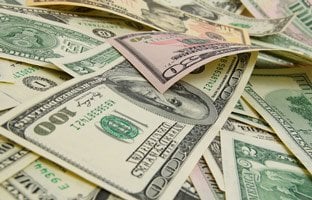If you're a huge fan of making unreasonably large piles of money, like me, or a self-described "Boglehead," you'll know that the legendary investor John C. "Jack" Bogle, of Vanguard Group, recently released his expected returns forecast, with extensive commentary, for the next decade.
Bogle, of course, has been doing these forecasts and commentaries for years, and it has to be said that he's far more accurate than many financial crystal-ball-gazers out there.
Here's his secret: Bogle takes the current dividend yield, factors in a growth estimate for earnings, and measures what he calls "speculative return."
If the price-to-earnings (P/E) ratio goes up, there's a positive expected return. On the other hand, if Bogle thinks the ratio will compress over the next decade, he'll call a negative speculative return that he subtracts from the earnings and dividend calculator.
It works pretty well. Now, he doesn't necessarily nail returns precisely to the last percentage point, but Bogle does have a knack for conveying the prevailing bullish or bearish conditions over the next decade.
But here's the thing: As much as I respect Bogle's experience and accurate track record, we've got a big difference of opinion.
You see, I think his return expectations, which I'll show you in a minute, are too low.
Essentially, Bogle and the "Boglehead" investors following along are settling for less - far less - than the unreasonable returns possible in a market like this.
Let me show you what kind of profits are possible - and how you can get at them...
Why Would Anyone Settle for Returns Like This?
 In this year's forecast, Bogle calls for 4% returns in stocks and 3% in bonds over the next decade.
In this year's forecast, Bogle calls for 4% returns in stocks and 3% in bonds over the next decade.
I'll tell you, that's very disconcerting, given that his 1999 forecast was for 5% stock returns. It means his expectations are lower now than they were back then.
So, if Bogle is anywhere near accurate, a blended "classic" portfolio of 60% stocks and 40% bonds is going to average about 3.6% a year.
Market-Crushing Returns: One recent recommendation closed out for a 995% win. Click here to learn more...
Trouble is, it's 2017: Valuations are higher, the economy is growing very slowly, and interest rates are about as low as they can go.
To put it mildly, that's not a favorable starting point for the average investor.
Now, here's where the index-loving Bogleheads and I part company.
[mmpazkzone name="in-story" network="9794" site="307044" id="137008" type="4"]
Like I said, their approach, as mandated by Bogle, is... just to accept the lower returns.
They stick with the indexing approach and count on a decade of higher returns to offset a decade of lower returns.
A Brief History of Thoroughly Underwhelming, Disastrous Returns
 Consider the 1970s, just for example.
Consider the 1970s, just for example.
If you weren't around then... maybe you're lucky. Because the seventies were awful for investors: "stagflation," an oil crisis, Nixon's Watergate, civil unrest, Carter's "malaise," and, of course, the Cold War's omnipresent threat of instantaneous global nuclear annihilation depressing the markets.
Stocks averaged just 2.6% for the decade, but that doesn't tell the whole depressing story. There were these horrific plunges where your account value would just go and plunge by 40% and 50%.
Sounds fun, huh? It was a thrill a minute.
Then along came Reagan's eighties, with all the junk actually worse. But as it turns out, it's a lot easier to put the whole "fiery Armageddon from the sky" thing out of your mind when money is cheap and it's piling up hand over fist. The S&P 500 gained an average of 10.65%, bringing our 20-year gains up to 5.88% a year.
 Then along came the wonderful nineties and a long national nightmare of peace and prosperity with Bill Clinton. There was Internet (and Internet "dot-com" stocks). The Cold War was over, just like the Soviet Union, and if Russia wasn't exactly our best buddy, at least the immediate threat was fading - almost as fast as interest rates and genuinely worthwhile dot-com companies, as it happens.
Then along came the wonderful nineties and a long national nightmare of peace and prosperity with Bill Clinton. There was Internet (and Internet "dot-com" stocks). The Cold War was over, just like the Soviet Union, and if Russia wasn't exactly our best buddy, at least the immediate threat was fading - almost as fast as interest rates and genuinely worthwhile dot-com companies, as it happens.
Stocks rode the tidal wave of good news and higher profits to an annual gain of over 14%. Investors' "patience" was rewarded, and annual returns jumped all the way back up to 9.24%.
 That only looks fantastic if you're a 25-year-old investor with a full 30 or 40 years ahead to recover from the initial, horrible results of your indexing strategy.
That only looks fantastic if you're a 25-year-old investor with a full 30 or 40 years ahead to recover from the initial, horrible results of your indexing strategy.
"9.24%" won't help you one damn bit if you're, say, the 55-year-old owner of an auto repair shop with a wife, two kids in college, and a couple hundred thousand in retirement savings. It won't help you because you'll never be able to recoup what you've lost in previous decades.
In that sad case, "9.24%" means "plan on working 'til you're 85."
You need to find higher returns. But the conventional wisdom, foisted on us by the entire financial services industry, says you can't earn higher returns.
They'll tell you your best bet is to tighten your belt, learn to make do with less... and just invest in their annuities, index and mutual funds, and, of course, all the other... packaged mediocrity... they have for you.
"Better yet," the industry types will tell you, "just give up on your future, sink every dime in a life insurance product, and go ahead and work until you drop dead - secure in the knowledge that at least your kids will do okay with your money. You can't earn higher returns, so just stay here in the middle of the herd. It's safe, comfortable, and requires very little effort on your part."
Horsepucky. That's financial horsepucky.
It's true that most professional investors can't beat the index. And it's true most individual investors do far worse.
That doesn't mean we can't grab much, much higher returns - it just means we can't do so by doing what everyone else is doing.
Let me show you...
This Strategy Works in Good Markets and Bad
These strategies require some more of your time, and there's a bit of a learning curve involved, but the payoff - and I do mean "the payoff" in the literal sense of the word - is that you can earn far higher returns than your friends and family who've been rooked into indexing with the rest of the Wall Street herd.
But I'll be there to help you every step of the way - I love investing this way - and I'll show you the best ways to execute.
 The first is one of my all-time favorites; I've used this with a good deal of success since I first learned about it back in the late 1980s.
The first is one of my all-time favorites; I've used this with a good deal of success since I first learned about it back in the late 1980s.
The closed-end fund strategy involves merely buying closed-end mutual funds that traded on an exchange, and doing it when they're unreasonably cheap, i.e., when they're at a 10% or greater discount to their net asset value.
There are lots of reasons, most of them psychological, for closed-end funds to trade at a discount to the value of the assets, but the most important things you need to know are that they tend to revert to the mean and will narrow over time.
There are also a small handful of activist investors that buy closed-end funds when they trade at a discount and then attempt to force management to do things like buybacks and tender offers to close the discount.
I limit my purchases to only those funds with an "unreasonably high" yield - more than 5% - so that month-in, month-out I'm collecting cold, hard cash no matter what the market does.
This will give you three sources of cash, or "return," if you'd rather: any gain in what the funds own, the narrowing of the discount, and the cash yield I collect along the way.
Look, I've been doing this and earning unreasonably good returns for years. The "Lost Decade-Plus One" of 1999 through 2010 was hands down the worst market environment I have lived through so far.
Think about it: We started the decade with the big dot-com crash and consequent recession. Then, we had the "hanging chads," the Sept. 11, 2001, attacks, two open-ended wars in the Middle East, another even more colossal credit crash, and a "recession" that looked a lot more like a global depression to anyone actually watching. And, of course, along the way, some of the bitterest political fighting we've seen since the Civil War.
Over those 11 tumultuous years, index investors, as exemplified by Jack Bogle, pulled in average annual returns - if you can call them that - of 0.18%.
On the other hand, Investors using a closed-end fund strategy like mine earned an average annual return of 13.70% - all with about half the risk of owning the indexes of packaged products like mutual funds.
There's just no comparison.
I'll be back to show you some more of my favorite, battle-tested strategies for taking down even bigger, market-crushing, "unreasonably" high returns.
An Incredible Win Rate: Since April 28, Shah Gilani's Zenith Trading Circle subscribers have had the opportunity to make average gains of 44% per day (including partial closeouts) on his recommendations. His win record is insane (in a good way). You've got to check this out - just click here.
Follow Money Morning on Twitter @moneymorning, Facebook, and LinkedIn.
About the Author
Tim Melvin is an unlikely investment expert by any measure. Raised in the "projects" of Baltimore by a single mother, he never attended college and started out as a door-to-door vacuum salesman. But he knew the real money was in the stock market, so he set sights on investing - and by sheer force of determination, he eventually became a financial advisor to millionaires. Today, after 30 years of managing money for some of the wealthiest people in the world, he draws on his experience to help investors find "unreasonably good" bargain stocks, multiply profits, and build their nest eggs. Tim tirelessly works to find overlooked "hidden gems" in the stock market, drawing on the research of legendary investors like Benjamin Graham, Walter Schloss, and Marty Whitman. He has written and lectured extensively on the markets, with work appearing on Benzinga, Real Money, Daily Speculations, and more. He has published several books in the "Little Book of" Investment Series and a "Junior Chamber Course" geared towards young adults that teaches Graham's principles and techniques to a new generation of investors. Today, he serves as the Special Situations Strategist at Money Morning and the editor of Peak Yield Investor.



